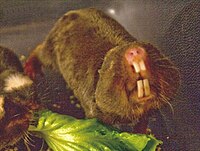Bathyergidae
| Blesmols Temporal range: Early Miocene–Recent |
|
|---|---|
 |
|
| Damaraland mole-rat | |
| Scientific classification | |
| Kingdom: | Animalia |
| Phylum: | Chordata |
| Class: | Mammalia |
| Order: | Rodentia |
| Parvorder: | Phiomorpha |
| Family: |
Bathyergidae Waterhouse, 1841 |
| Genera | |
|
|
The blesmols, also known as mole-rats, or African mole-rats, are burrowing rodents of the family Bathyergidae. They represent a distinct evolution of a subterranean life among rodents much like the pocket gophers of North America, the tuco-tucos in South America, or the Spalacidae.
Modern blesmols are found strictly in sub-Saharan Africa. Fossil forms are also restricted almost exclusively to Africa, although a few specimens of the species Cryptomys asiaticus have been found in Israel. Nowak (1999) also reports that †Gypsorhynchus has been found in fossil deposits of Mongolia.
Blesmols are somewhat mole-like animals with cylindrical bodies and short limbs. They range from 9 to 30 cm (3.5 to 11.8 in) in length, and from 30 to 1,800 g (1.1 to 63.5 oz) in weight, depending on the species. Blesmols, like many other fossorial mammals, have greatly reduced eyes and ear pinnae, a relatively short tail, loose skin, and (aside from the hairless naked mole rat) velvety fur. Blesmols have very poor vision, although they may use the surfaces of their eyes for sensing air currents. Despite their small or absent pinnae, they have a good sense of hearing, although their most important sense appears to be that of touch. Like other rodents, they have an excellent sense of smell, and they are also able to close their nostrils during digging to prevent them from clogging with dirt.
The eyes of blesmols are structurally normal, despite their relatively small size, and include normal light-sensitive cells. However, the visual centres of their brains are reduced in certain respects, especially in those centres concerned with localising objects in the visual field. Research has shown that at least two species of blesmol (Fukomys mechowii and Heliophobius argenteocinereus) are not blind, as commonly believed, and will actively avoid blue or green-yellow light. They do not appear able to detect the presence of red light, and can probably not distinguish between different colours. The ability to sense the presence of light is probably useful in allowing them to detect breaches in their tunnel systems and repair them promptly.
...
Wikipedia
